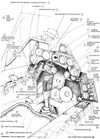 |
The Focke Wulf FW190 is a legendary German aircraft of the second world war which proved to be a deadly foe to Soviet, British and American airforces. When it was first introduced into operation in the autumn of 1941, this aircraft could out-run, out-climb, and out-dive the best fighter the Royal Airforce had – the Spitfire V.
There were many versions of this aircraft, but its most successful role was that of a fighter. It was also used for ground attack however and in fact, was the only reliable light attack bomber that the Germans had in numbers.
The basic layout of the Focke Wulf 190 was entirely conventional, being a monoplane with a nosemounted engine driving a tractor airscrew. The mainplane was fully cantilever and was fitted with split flaps of metal construction. These were operated by means of three electric push buttons situated in the cockpit. A low wing gave adequate housing for the retractable undercarriage which meant that the legs could be kept short, optimising pilot vision. This was further enhanced with a large frameless bubble canopy, which when first introduced, was quite an innovation.
The A-8 version (fig.4) was powered by the BMW 801D-2 engine, which was a very rugged air cooled radial (see below). There were fittings under the fuselage to enable it to carry bombs or a jettisonable fuel tank of 300 litres capacity.
| Figure 4: Schematic diagram of the FW190A-8. | |
 |
In the cockpit 80 levers, slide controls, dials and buttons were divided into two instrument panels and three consoles. Amongst the apparatus on board, was the RM 16B sighting mechanism which permitted precise weapons aiming to a range of 900 meters. It could also be used with a night filter (fig.5.). In the rear section of the fuselage was found the FuG 25a radio installation which also served to identify friend and foe.
| Figure 5: FW190A-8 cockpit layout. | |
| Click on the small drawing to open a full-size version in a new window. | |
No less than nine model designations were assigned to the Fw 190A-8, most of these being based on varying armament configurations.
 |
Copyright 2021 by TIGHAR, a non-profit foundation. No portion of the TIGHAR Website may be reproduced by xerographic, photographic, digital or any other means for any purpose. No portion of the TIGHAR Website may be stored in a retrieval system, copied, transmitted or transferred in any form or by any means, whether electronic, mechanical, digital, photographic, magnetic or otherwise, for any purpose without the express, written permission of TIGHAR. All rights reserved. Contact us at: info@tighar.org • Phone: 610.467.1937 • JOIN NOW |
